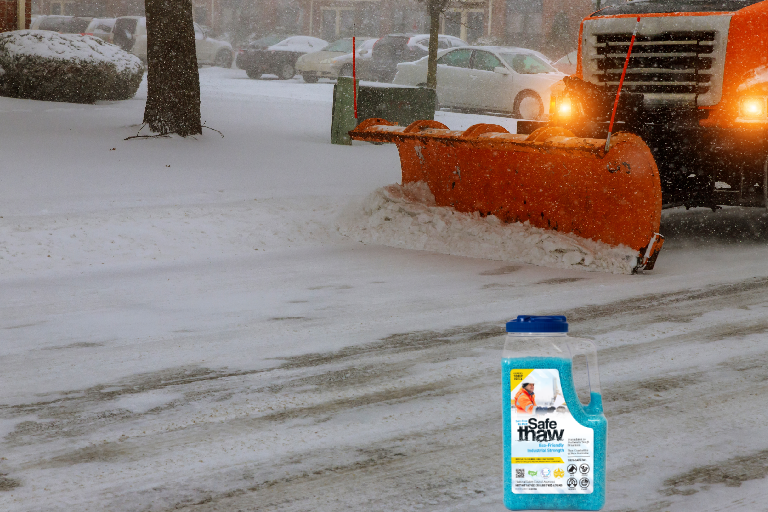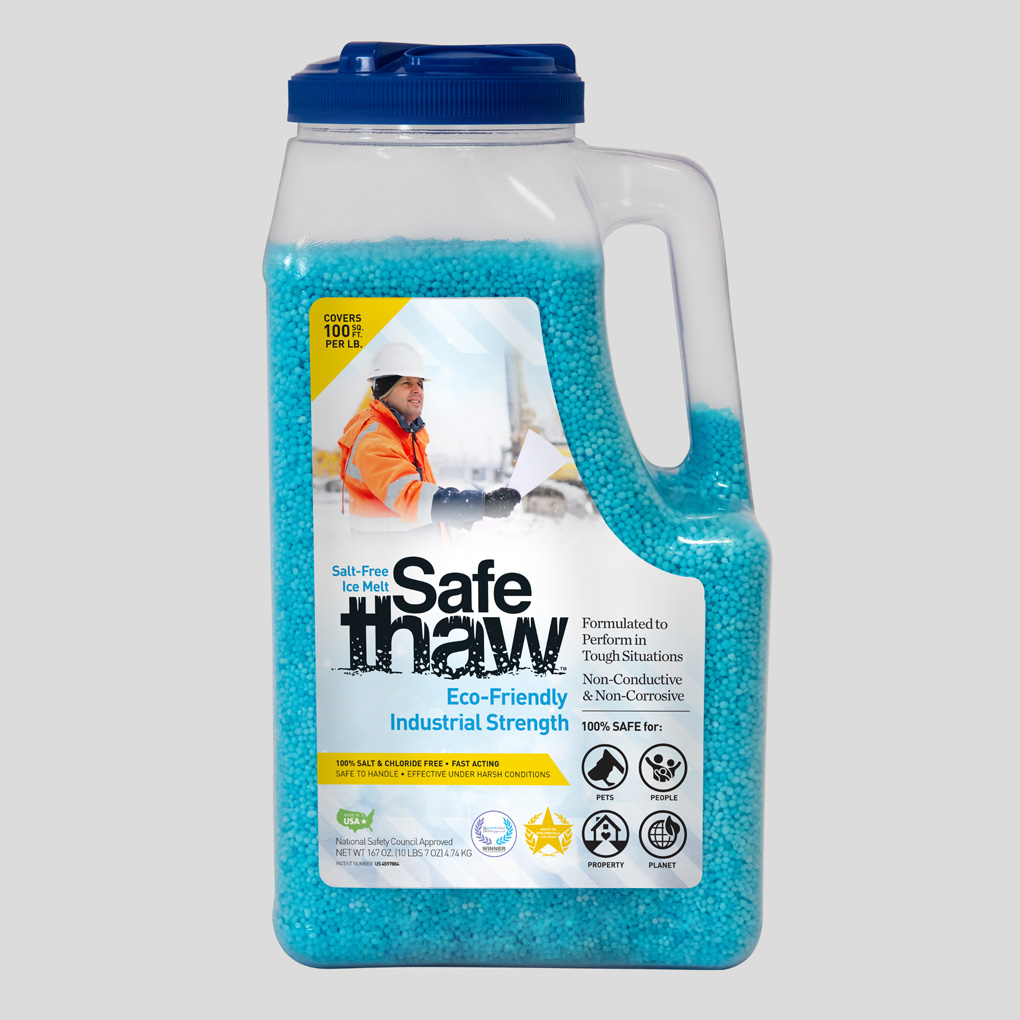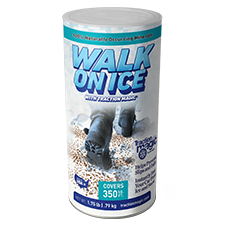What Temperature Does Ice Melt? Uncovering The Science Behind Melting Points

Ice, in its purest form, is crystalline water. It guards the earth’s polar regions, leisurely floating in your summer lemonade, and often becoming an unwanted guest on your driveway or sidewalk when winter strikes. But “what temperature does ice melt?” you may wonder, and what forces drive this transformation from a rigid solid to a flowing liquid?

Safe Thaw
Safe Thaw was created as the ice management solution for tough winter environments. Ideal in commercial and industrial properties, shops, government agencies, bridges, and construction.
The Science Of Melting Ice
Let’s delve into the world of physics. At 32 degrees Fahrenheit (0 degrees Celsius), ice undergoes a phase transition, the process where a substance changes from one state of matter to another. In this case, the change is from solid (ice) to liquid (water). Interestingly, this transition doesn’t occur abruptly; it’s not like ice suddenly decides to melt the moment the thermometer hits 32F. A certain amount of energy, called latent heat, is required for the ice to break free from its solid state.
Speeding Up The Process: A Dash Of Salt
In colder climes, waiting for the temperature to rise above freezing is a slow and potentially hazardous process. So, the query “how long does it take salt to melt ice?” often surfaces. The answer lies in the magic of chemistry. Salt disrupts the structure of ice, lowering its freezing point. The more salt is spread, the more rapidly ice melts. However, remember that the speed of this process heavily depends on the ambient temperature and salt concentration.
But Hold On, Isn’t There A Better Way?
While using chemical ice melts like rock salt or calcium chloride seems efficient, they come with an environmental price tag. They can contaminate groundwater, damage vegetation, and pose a risk to pets and wildlife. The solution lies in an innovative product called Safe Thaw.
Introducing Safe Thaw: Efficient, Safe, And Eco-Friendly
Safe Thaw, a revolutionary ice melt, prides itself on its non-toxic and chemical-free formulation, making it perfect for industrial use. It effectively battles icy surfaces, turning them into safe zones, even in the harshest of winters. Its secret lies in a potent, yet eco-friendly formula that begins to act fast, delivering impressive ice melting performance without the environmental toll.
Safe Thaw strikes a perfect balance between efficiency and sustainability. While it tackles the ice swiftly, it doesn’t compromise on safety. So, whether you’re maintaining a large industrial facility or simply want to keep your home’s walkways clear of ice, Safe Thaw is an option worth considering.
Redefining Ice Melt
Understanding “what temperature does ice melt” is essential, but comprehending how to speed up the process without harming our environment is crucial. Safe Thaw stands out as a beacon of hope in the battle against icy surfaces, promoting safety, efficiency, and eco-friendliness. So, why not choose a product that doesn’t only care about melting ice but also cares about the world we live in?
What Temperature Does Salt Stop Melting Ice?
Now that we know why ice melts at 32°F (0°C) and how salt interferes with the freezing process, the next logical question is: does salt work forever? The short answer is no. Salt has a limit, and once temperatures plunge too low, it simply stops being effective. So, what temperature does salt stop melting ice? Typically, rock salt (sodium chloride) stops working effectively around 15°F (-9°C). Below this, sprinkling more salt won’t make much difference—your driveway or sidewalk will remain a frozen sheet.
Here’s where it gets tricky: many people assume adding double the salt will double the melting power. But once you hit that temperature threshold, the salt is like a bystander—it just sits there. That’s one reason why harsh winters often demand alternatives that don’t rely on the same freezing-point depression method.
Melting Temperature Of Salt And Ice Explained
When talking about the melting temperature of salt and ice, it’s less about salt melting itself and more about how salt affects water’s freezing point. Pure table salt has its own melting temperature of about 1474°F (801°C), far beyond anything we’d deal with in a winter storm. But when salt mixes with ice and water, it creates brine—a salty solution—that lowers the ice melting temperature.
Still, it only lowers it so far. If the weather dips well below zero, even the brine freezes, and the process halts. That’s why people often look for ice melt products designed for extreme cold—ones that don’t rely solely on sodium chloride. And it’s also why Safe Thaw’s formula makes sense; it works in sub-zero conditions where salt alone would give up.
What Temperature Does Salt Melt In Celsius?
If you’re used to thinking in Celsius, you might wonder: what temperature does salt melt in Celsius? Pure sodium chloride melts at about 801°C, but again, that’s irrelevant to your icy steps. The more practical point is understanding at what Celsius temperature salt stops helping ice. Converting 15°F gives about -9°C. So, below -9°C, traditional salt on your driveway won’t keep you safe from slips.
This raises a fair question: what’s the use of relying on something that quits when you need it most? Salt might handle light frosts or mild snowfalls, but during a deep freeze, it won’t keep up. That’s why property owners, from industrial sites to family homes, increasingly explore chloride-free options like Safe Thaw—because winter isn’t always mild.
Ice Melting Temperature Vs. Real-World Winter
Here’s the kicker: science tells us the ice melting temperature is fixed at 0°C (32°F) under normal conditions. But the real world complicates things. Add salt, and you lower the freezing point. Lower the surrounding temperature too much, and the salt effect disappears. It’s a tug-of-war between chemistry and climate.
Think about it this way: if your thermometer reads -15°C (5°F), that bag of rock salt in your garage isn’t going to rescue your steps. But a product engineered to work below those limits, without damaging concrete or lawns, might. That’s where the conversation shifts from simply “what melts ice” to “what melts ice safely when salt fails?”
100% salt & chloride-free, fast acting Ice Management Solution
Conclusion
So, circling back to our original curiosity about what temperature does ice melt and how salt fits into the equation, the answer isn’t as simple as one neat number on the thermometer. Sure, ice melts at 32°F (0°C) in its pure form, but once salt enters the picture, the rules change. Depending on the concentration and conditions, the ice melting temperature can drop significantly, but it still has its limits—meaning salt eventually stops working in extreme cold.
That’s where products like Safe Thaw step in. By moving beyond corrosive salts and harnessing an eco-friendly, chloride-free formula, it delivers performance even when traditional salt-based methods quit. And isn’t that what we’re really after—safety without compromise?
Next time you’re facing down a winter storm, you’ll know the science, the chemistry, and the smarter choice. Because winter may test us, but the right knowledge—and the right tools—help us win every time.
Try Also Our Other Winter Safety Products:
Safe Paw
The Original and #1 Selling Pet and Child Safe Ice Melt for over 20 years. Guaranteed environmentally safe –It won’t harm animals or children, and it won’t damage your property. That’s Safe Paw. Safe Paw can change how winter affects our planet.

Walk On Ice
The handy disposable canister can be taken everywhere, with the same 100% naturally occurring minerals that provide instant traction on ice or snow. Use it on sidewalks, steps, or as an instant traction agent for your car.



